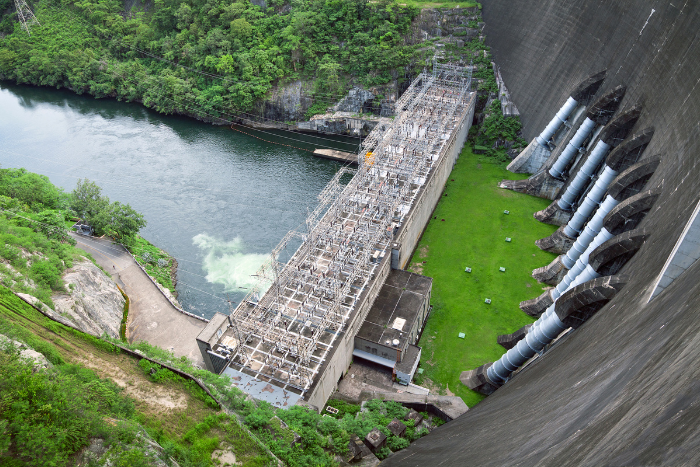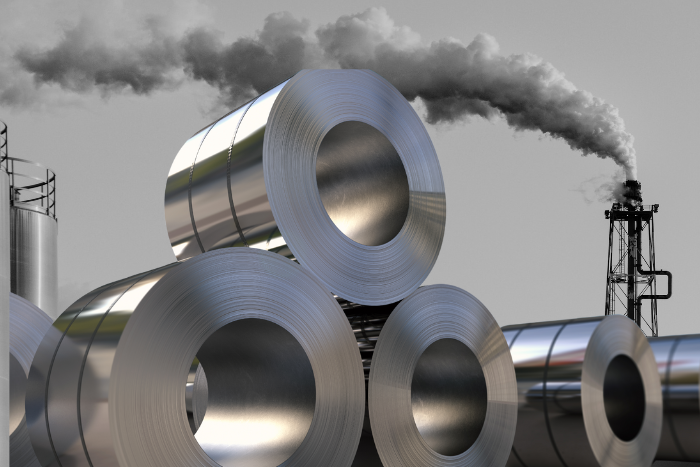
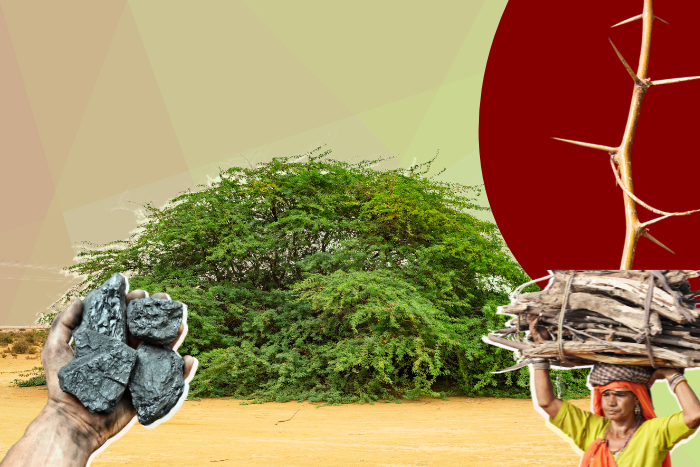

Climate change is projected to exacerbate the spread of invasive alien species like Neltuma juliflora in India—which has now become an integral part of the ecosystem it invaded, with several sections of society dependent on it. Experts say aiming to control the invasive species, rather than eradicating is the way forward. Read more
Given the ways Neltuma juliflora has become integral to people’s lives in regions it has invaded, experts say eradicating it is not the best way to go.
Kill or keep: A thorny invasive shrub is shaking up India’s ecosystem
Climate change is projected to exacerbate the spread of invasive alien species like Neltuma juliflora in India—which has now become an integral part of the ecosystem it invaded, with several sections of society dependent on it. Experts say aiming to control the invasive species, rather than eradicating is the way forward
Among the many ways that climate change threatens life on Earth, there is one that is not talked about as much—aiding the spread of invasive alien plant species. A new report found that under two climate change scenarios—representative concentration pathways (RCP) 2.6 and 8.5—the share of land under protected areas that will become conducive for the spread of Neltuma juliflora—a widespread invasive alien species in India—will rise. According to the report, several protected areas which are home to a range of amphibians, reptiles, birds and mammals are located in these areas. Spread of Neltuma juliflora in such biodiversity rich areas would mean a habitat loss for these organisms and a disruption in the ecosystem.
Last year, the Intergovernmental Platform on Biodiversity and Ecosystem Services (IPBES) released their first ever and most comprehensive Assessment Report on Invasive Alien Species, which said that they are one of the five major direct drivers of biodiversity loss globally and are costing $423 billion annually.
While eradicating them seems like the most obvious way forward, experts say it is more complicated than that. First, it is not easy to reclaim land which has been invaded by this alien species for over a century. Second, Neltuma juliflora has become quite an integral part of the ecosystem it has invaded—providing locals with resources and ways of earning livelihoods. Third, when the going gets tough due to climate-induced erratic weather patterns like drought, the invasive species becomes a reliable ‘plan B’ for those otherwise engaged in agricultural/dairy activities. While it colonises farmlands, driving out farmers, it provides income to the landless. Different socio-economic groups perceive it differently—leading to the conundrum of keeping it or killing it.
Experts recommend finding a middle ground. Controlling the spread, rather than complete eradication, because that is not only practical, but also beneficial. At the same time, popularising indigenous ways to use this invasive species can help address the issue, CarbonCopy finds.
A brief history of Neltuma Juliflora
Previously called Prosopis juliflora, the invasive species is natively called vilayati babool or vilayati keekar. It is a thorny woody shrub or small tree, which grows up to 5-10 m in height. The trees form dense thickets in open lands in arid to semi-arid regions across the country.
So where did they come from? There isn’t one single answer to that question. Native to South America and Mexico, researchers say that it was “introduced in India in 1857 intentionally to halt further ‘desertification’ in the Thar desert, and in 1878 to peninsular India as a source of fuelwood”.

A video by the Ashoka Trust for Research in Ecology and the Environment (ATREE) explains how the Neltuma juliflora was aerially seeded by the Maharaja of Jodhpur in the mid 1930s.
According to the Food and Agriculture Organization (FAO) of the United Nations, Neltuma juliflora is now found in many states of India, including Andhra Pradesh, Karnataka, Maharashtra, Orissa, Punjab, Uttar Pradesh, Tamil Nadu and West Bengal, and in almost all districts of Haryana, Gujarat and Rajasthan.
A blessing and a bane
Now standing in all shapes and sizes, the invasive species has become omnipresent—taking over roadsides, grasslands, protected forests, nature reserves, abandoned farms, grazing lands, irrigation channels, and river beds alike.
“It’s not just because they are invasive that they spread anywhere. It is partly triggered by what we do. A lot of invasive aliens often occupy areas that have been impacted or disturbed or damaged by other forms of human actions. It makes a disturbed open habitat, which then becomes conducive to the spread. So, take a forest that has been logged, burnt, and then it leads to a habitat, which becomes conducive to their spread,” explains T R Shankar Raman, Scientist, Nature Conservation Foundation (NCF).
In Banawas, at the bank of sand river Luni in Rajasthan–where rampant illegal sand mining has altered the river ecosystem—Pukhraj Prajapat, a retired farmer, points at a full grown Neltuma juliflora tree. He says, “Yeh to sabse bura hai, vinaash karta hai, jaha tak iski chaaya padti hai, waha kuch nahi udgta (this is the worst of all, leads to destruction, nothing else grows under its shadow),” pointing at the clear ground underneath the tree.
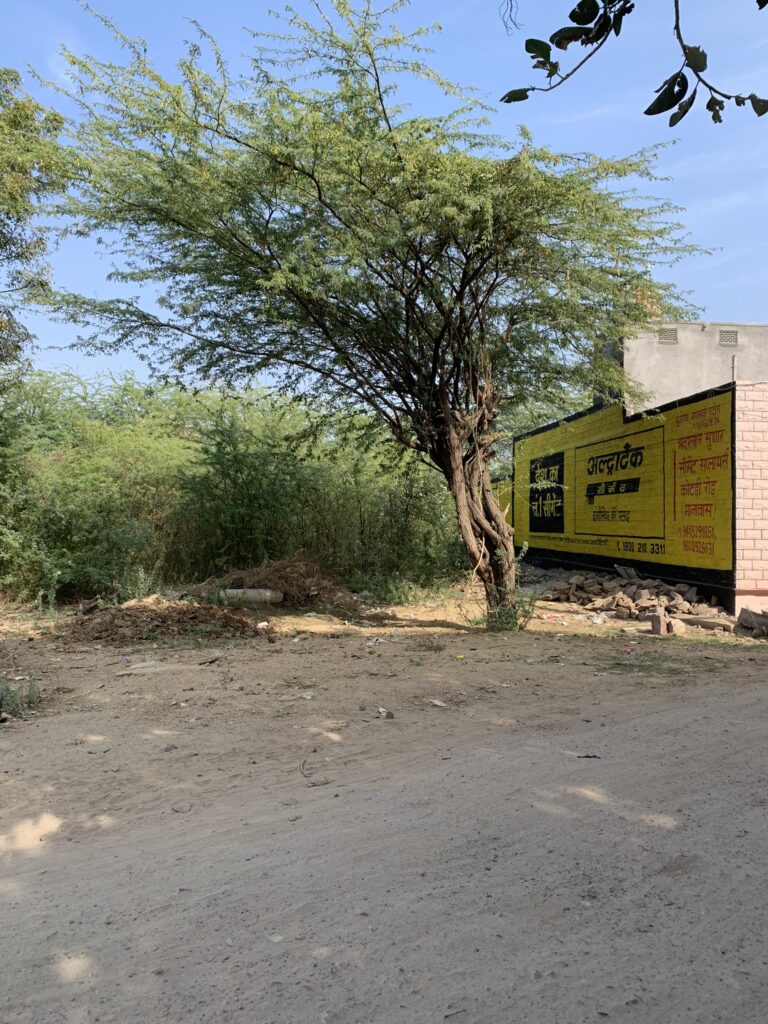
Prajapat is talking about the allelopathic effect of the invasive. This means that Neltuma juliflora discourages other plants from growing around it. It is toxic to other biota, monopolising space and nutrients while excluding other species. In the native habitats of Neltuma juliflora, other species have developed a mechanism to counter its allelopathic effect, but such a defence is not available to plants for which Neltuma juliflora is an alien.
In many ways, this is an invader full of contradictions.
On the one hand, it provides affordable firewood, animal feed, medicine, timber, honey, and charcoal in developing nations such as Kenya, Ethiopia, Nigeria, and India. On the other hand, its remarkable adaptability to survive and flourish in extremely harsh desert situations has made it a major weed, invading the space for humans and animals alike. A water-guzzling species with deep roots, the shade it provides poses a threat to the ecosystem, altering the composition and lowering the number, richness, and variety of understory plant species. Its spread has led to the replacement of many native species like Acacia nilotica, Mitragyna parvifolia, Prosopis cineraria, Salvadora oleoides, Salvadora persica, and Ziziphus mauritiana in Keoladeo National Park, Rajasthan. The blackbuck population in the Sathyamangalam Tiger Reserve in Tamil Nadu has also been affected by its spread.
But for those who depend on the tree, calling it “the worst of all” can seem disrespectful.
The coal makers
The most common Neltuma-juliflora-based enterprise is charcoal manufacturing. In Lakhar Thumb village of Jodhpur district, Rajasthan, the Jogi tribe— which was traditionally engaged in jute artisanship to make jute bags and baskets— burns the invasive tree to make charcoal. As cheap plastic products swiftly drove jute products out of the market, the tribe turned to coal making.

Ashuraam Jogi, along with his family, does this work all year round— barring monsoon when the wood is wet. The family cuts vilayati babool, cleans it up and stocks the logs to make a bhatti (furnace) and sets it on fire after covering it up with hay. The lots can vary in size, but typically each lot fetches about six to seven quintals of charcoal, which is sold at the rate of about ₹10-12/kg. Typically, they end up making about ₹30,000 a month. The whole procedure to gather the wood, clean it, cut it, burn it and cool it can take about a week or ten days, Jogi says. But the most popular use of Neltuma Juliflora is also the most emission-heavy enterprise.
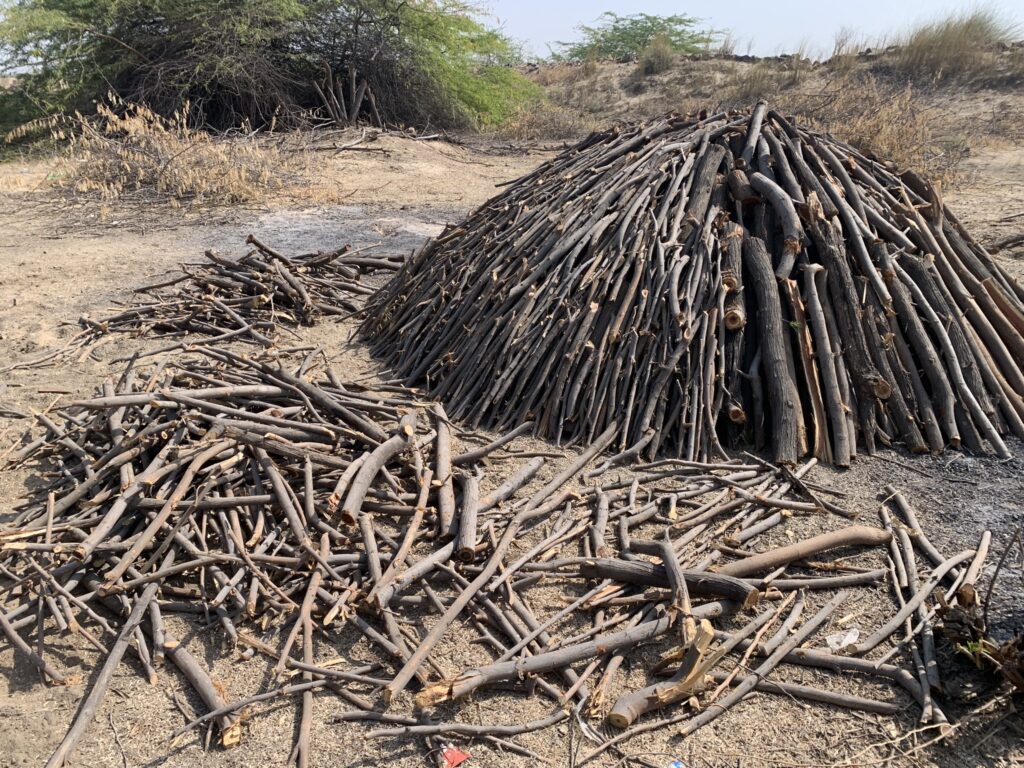
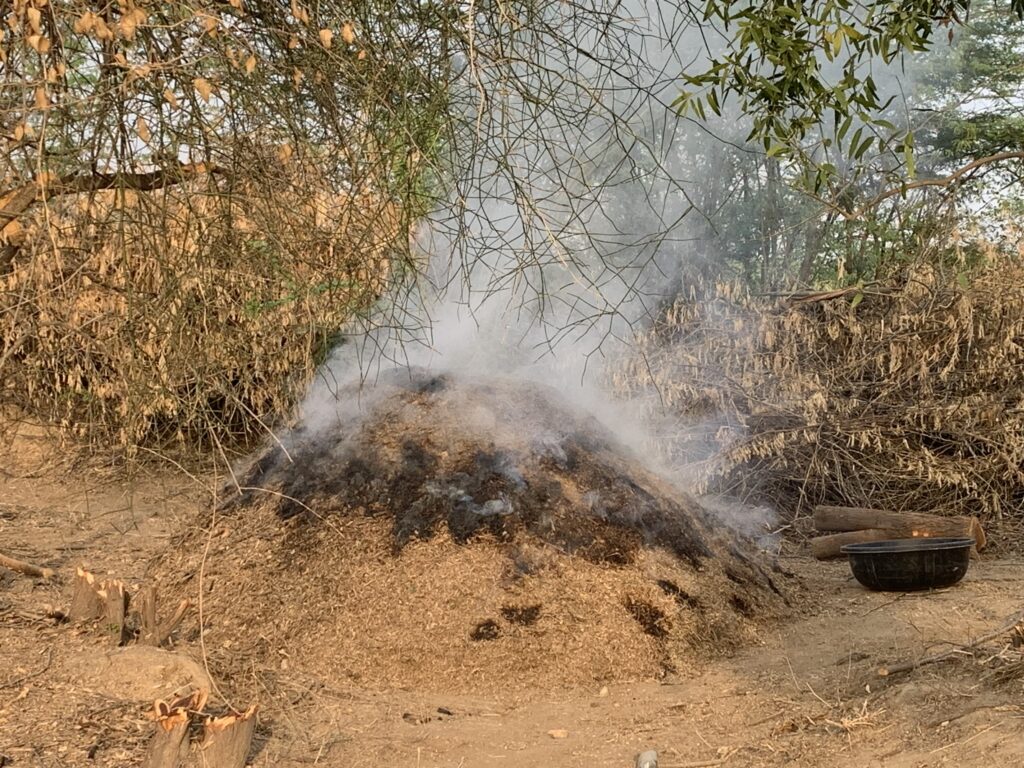
The migratory pastoralist community of Maldharis in Kutch, Gujarat, are engaged in the same occupation. Independent photographer, writer, and National Geographic explorer Arati Kumar-Rao talks about the extent of the practice in a podcast, where she recounts passing through villages in Kutch one night with “zero visibility” as locals burnt Neltuma juliflora to make charcoal. “You can’t breathe, it’s black-thick smoke” she says.
Rao also raises a concern arising from this practice. She asks, “How many people really know Prosopis juliflora ( Neltuma juliflora) from a native babool? Not too many.” She wonders if those who take their JCBs to uproot Neltuma juliflora don’t uproot the native counterpart with it.
“Most people from the area can easily tell desi babool and vilayati babool apart, it’s not that difficult. For someone not familiar with the species, it may take a while to learn to distinguish between them. But they are very distinctive, the branching pattern of Neltuma juliflora is zigzag, desi babool is very straight and its branches are not crooked like those of the vilayati babool. The flowers are different,” says Ankila Hiremath, Adjunct Senior Fellow, ATREEE.
Citing the example of Banni grasslands in Kutch, Gujarat—where the rate of Neltuma juliflora’s spread is as high as 25.5 km2 per year, Hiremath says that there is always a danger of that (uprooting native trees alongside) but it doesn’t always have to be the case.


Readily available fuelwood
It is not just the charcoal makers who benefit from the invasive species. In many districts of Rajasthan, CarbonCopy finds that women fuel their traditional stoves with the wood. With sporadic supply of LPG cylinders in the region, Neltuma juliflora is still a reliable everyday source of fuel for many households.

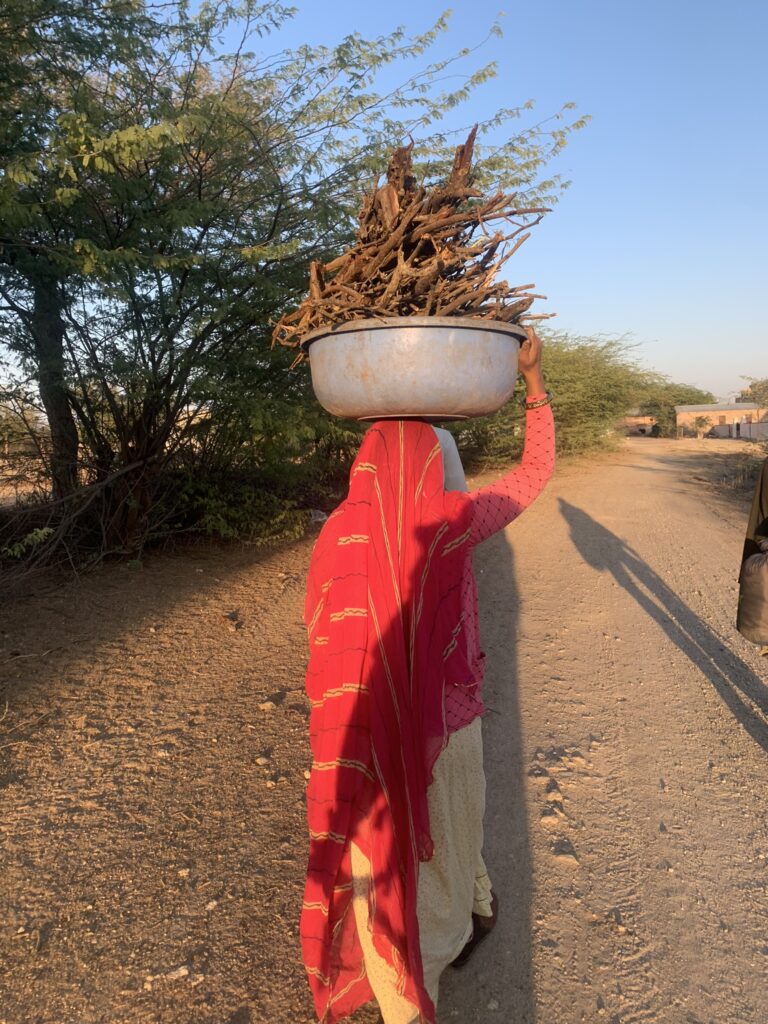

A local farmer tells CarbonCopy that they use ash from the stoves in farming, too. The ash is spread over the soil where onions and garlic are grown to retain the moisture in the soil. This has to be done only with these two crops, otherwise the crop will rot, the farmer warns.


The invasive has also been used to make furniture as its abundance has made it an affordable option for many. Various reports have mentioned its use as timber.
“It is cheap but it doesn’t last long. Furniture made out of its wood is also prone to termites,” says Raju Bishnoi, a resident of Barna, Rajasthan, pointing at a termite-infested door frame made out of vialyati babool in his house.
The forgotten pods
While charcoal-making is the most common economic enterprise, less attention has been paid to products made from parts of the invasive—for instance, its pods. The species’ seed pods are cylindrical, up to 10 cm long.
According to a study, the flour made from these pods has been a food item in North and South America since centuries, but it must be eaten in moderation and as a minor supplement to flour of other grains. Neltuma juliflora pod flour is rich in sugars, moderate in proteins, and low in lipids. It contains phosphorus and calcium.
Locals from Bhacharna village in Rajasthan tell CarbonCopy that they commonly consumed pods—locally called babool falis or babool khokha— as kids. But it is not so popular anymore as there’s social stigma attached to abundantly available pods for free.
However, pods are more popular as livestock feed. Goats chew on the pods as they fall to the ground or hang on low branches. Reports emphasise that no feed containing only the pods, or with pods as the major fraction, is safe. Most reports recommend that pods should constitute no more than 20% of any feed as higher fractions are a health hazard.
“It is used as fodder. But not all livestock can tolerate it. The Maldharis in the Kutch say cows can’t stand it. They say ‘Unke pet me gaanth ban jaati hai’ (it leads to knot formation in their stomach). So goats, buffaloes and camels seem to tolerate it, but cows can’t,” explains Hiremath.
Untapped potential
Research has shown that native pollinators are drawn to the vibrantly coloured Neltuma juliflora flowers since they provide a supply of nectar and pollen. The end product is high-quality honey. The gum that emerges from the stem and branches of Neltuma juliflora forms sticky mucilage that can be used to mend ceramics and as an emulsifying agent in confections.
In fact, the same research mentions Indian civilisations in central-northwest Mexico and the southwestern United States have been using Neltuma juliflora gum extensively since pre-Columbian times. It was primarily used as a sweet, an ingredient in food for people and animals, and a medicinal remedy for conditions like diarrhoea, stomach aches, sore throats, and pain in the eyes. It was also used to treat open wounds and prevent infections. In Mexico, Neltuma juliflora gum is still used in small-scale processing enterprises, which mostly deal with food and confectionery products.
However, these uses remain limited, seasonal or unknown in India. Only charcoal reigns supreme as the most profitable venture.
Controlling over eradicating
Given the ways Neltuma juliflora has become integral to people’s lives in regions it has invaded, experts say eradicating it is not the best way to go.
While more affluent communities advocate for eradication, the poorer communities depend on it. “When we saw parts of the community who are entirely dependent on Neltuma juliflora, we realised that the problem is much more complex. There are those who see it as a key resource during pinch periods like droughts. So, complete eradication and restoration is not feasible. But there may be certain parts of the landscape in which trying to control them is more worthwhile,” explains Hiremath.
But where can this process begin?
“Ecologists often say that a high priority area for dealing with invasion is where it is spreading right now. That’s the place we should first target and work at the invasion front into the other side. Then you have a way of expanding the natural ecosystem rather than the other way around. Unfortunately, it doesn’t work that way. When people think of removal of woody species like Neltuma Juliflora, they tend to target intensive areas with thick wood as it brings charcoal, timber, etc. but they don’t succeed. Such lands are recolonised,” answers Raman.
Controlling these invasive species requires a plan. Apart from understanding the causes, it is crucial to build a restoration plan, which is often labour-intensive and spans over several years.
“It can’t just be a removal. What comes next? Sometimes the same species can recolonise the area, sometimes secondary invasion— which means another invasive may invade. There should be a plan for ecological restoration of that area depending on the kind of ecosystem it is. If it’s grassland, you want to encourage grass to come back. You can’t just remove it and hope that it is gone,” says Raman.
While the ecological restoration should be attuned to the kind of ecosystem it is, the plan also needs to include local community members. They are often well-informed about their native species and restoration activities could be turned into employment opportunities for them, Raman adds.
As climate impacts worsen, the land under the invasive will grow—further exacerbating the issue of water scarcity and threat to biodiversity. At the same time, efficient use of the resources from Neltuma juliflora can help revitalise struggling local economies. The answer lies in a balanced approach which counters the spread while optimising the use of this alien invader.
This article has been produced as part of Veditum India Foundation’s Moving Upstream fellowship programme.
84% of Indian districts are prone to extreme heatwaves, with 70% of them also witnessing increased frequency and intensity of extreme rainfall events.
Summer conditions extend to monsoon months in India: Study
Most of India’s districts are experiencing extreme humid heat even during monsoon months (June, July, and September), according to a new report titled “Managing Monsoons in a Warming Climate”, reported HT.
The study released ahead of the NYC Climate Week scheduled for September, states that over 84% of Indian districts are prone to extreme heatwaves, with 70% of them also witnessing increased frequency and intensity of extreme rainfall events.
The newspaper writes:”Extreme heatwave days across the March-April-May (MAM) and June-July-August-September (JJAS) months have risen 15-fold in the last three decades. In the past decade alone, there has been a 19-fold increase in extreme heatwave days.” Extreme heatwaves and rains are causing loss of lives and livelihoods, the report said.
Over 140 mm rainfall that triggered Wayanad landslides was Kerala’s third-heaviest rainy day: Study
The over 140 mm rainfall on July 30, 2024 in Northern Kerala that triggered multiple landslides in Wayanad was historically Kerala’s third heaviest monsoon day and is linked to human-induced climate change, says a study by the World Weather Attribution (WWA). The rain landed on soils that were already highly saturated with 30 days of continuous rain, the analysis underlined.
The climate crisis made rain 10% heavier, but the 62% reduction in forest cover increased the susceptibility of the slopes to landslides, HT reported citing the same analysis. The landslides in Mundakkai and Chooralmala in Meppadi claimed more than 230 lives. The Kerala Bank waived off the loans of victims and survivors of the landslides.
Building roads, changing land use impact genetic connectivity of herbivores in central India: Study
A new study found that changes in land use patterns and the development of roads in central India are disrupting the genetic connectivity of large herbivores gaur and sambar.
The study stated that both gaur and sambar responded negatively to land use changes, and the impact was more pronounced in gaur populations.
Mongabay reported that the researchers hope that studies like this will help spur evidence-based approaches to maintaining connectivity for multiple endangered species in priority landscapes like central India.
Mumbai, Panaji, Chennai may lose 10% land to rising sea; Mangalore, Udupi 5% by 2040: Study
Around 5% of land in coastal Karnataka’s Mangalore and Udupi, over 10% of land in Mumbai, and up to 10% in Panaji and Chennai may go under sea by 2040 due to climate change-induced sea-level rise, according to a new study by Bengaluru-based think-tank Center for Study of Science, Technology and Policy (CSTEP).
Marine geologist R Shankar at Mangalore University told Down To Earth that the best thing to do is to stop construction activities on and near the coastline. And move away from the coast, allowing nature space to play. Marine geologists of National Institute of Oceanography (NIO) in Goa told the DTE, lakhs of rupees are spent on the ineffective practice of dumping boulders along the shores. This exacerbates the rise of sea level, disrupting the natural flow of sand. They pointed out that the sand removed by the sea is typically returned to the same location before the next monsoon, a process hindered by artificial barriers.
Atlantic sea surface temperatures significantly impact frequency of extreme heatwaves in US
Sea-surface temperatures in the Atlantic Ocean significantly influence the frequency of compound humid heat extremes – the deadly co-occurrence of high temperatures and humidity – in southeastern US, stated a new study. Using an Earth-system model, researchers studied a range of factors that could potentially help predict the onset of these extreme events.
They find that abnormally warm ocean temperatures can affect the atmospheric circulation, bringing heat and moisture from the Gulf of Mexico to the south-eastern US. They conclude that “the results of this study have potential applications in the development of early warning systems” for humid heat extremes.
UN science body IPCC’s input into key UN climate review at risk; countries clash over timeline
Countries once again failed to agree on a timeline for producing key climate science reports (AR7: 7th assessment report) over political differences at a meeting of the U.N.’s Intergovernmental Panel on Climate Change (IPCC) recently, Climate Home reported. At the talks in Sofia, Bulgaria, rich countries and vulnerable island nations supported a faster process that would see three flagship reports assessing the state of climate science delivered by mid-2028, in time for the next global stocktake – the UN’s scorecard of collective climate action. But developing countries China, India, Saudi Arabia, Russia and South Africa – backed by Kenya – opposed an accelerated timeline, arguing that more time is needed to ensure greater inclusion of experts and research from the Global South, which would result in “robust and rigorous” scientific output.
Earlier, “fraught talks” in January ended with the same outcome. The issue will be debated again at the next gathering in February 2025, while a separate expert meeting is tasked with drafting the outline of those reports by the end of 2024. The climate news outlet said the IPCC has long struggled with ensuring adequate representation of expert voices from the Global South. Only 35% of the authors working on its sixth and latest assessment report hailed from developing countries, according to a study published in the journal Climate, up from 31% in the previous cycle.
Ahead of last week’s meeting, a group of 40 IPCC authors from developing countries published an open letter arguing that the AR7 reports “can and must” be produced by June 2028 in order to remain policy-relevant.
Above 36°C temperature throws curveball at Paris Olympics
As the Olympics 2024 began in Paris, most of France was under heat warnings, with temperatures in Paris hitting 36°C, Carboncopy reported. According to the Climate Central’s Climate Heat Index, high temperatures in Paris were made four times more likely because of climate change.
The average temperature during the months of the 2024 Summer Olympic Games has risen by 3.1°C since 1924, with scientists at Climate Central warning that “scorching days (with highs of 30°C or above) are now nearly three times more frequent in Paris than when the city last hosted the Games.”
Athletes wore ice vests as temperatures reached 35°C at the Olympic Games in Paris on July 29, BBC News reports adding: “The sailing events are taking place in Marseille, on the Mediterranean coast in the south of France, where competitors wore ice vests to try to counteract the heat…Tennis players were given an extended break between the second and third sets in the men’s and women’s singles.”
The power ministry secretary wrote to the MoEFCC, requesting that the dispensation provided to mining projects for drilling 25 bore holes and felling of 100 trees be extended to hydro and pump storage projects also.
Green clearance not needed for some development survey work in forest areas
The Centre did away with rules that require prior forest clearance for development project surveys involving drilling and felling of up to 100 trees for hydro projects in forest areas. The statutory body, the Forest Advisory Committee (FAC), exempted hydel and other development project surveys from taking permission saying that such surveys “are of relatively lesser intensity and do not result in any permanent change in the forest land use”, the HT reported.
“Such preliminary drilling is crucial for project design, preparation of detailed project report and estimating the financial provisions of the proposed development project,” the newspaper cited the official minutes adding the FAC considered the matter following a request by the Union power ministry. The power ministry secretary on May 28 wrote to the MoEFCC, requesting that the dispensation provided to mining projects for drilling 25 bore holes and felling of 100 trees be extended to hydro and pump storage projects also.
Eco-sensitive Char Dham road near China border to be 10 m wide
The last 150 km-long stretch of Char Dham road, which will pass through the Bhagirathi Eco-Sensitive Zone, will have to adhere to a minimum width of 10m, Union transport minister Nitin Gadkari said. He said as it connects with the India-China border, the road needs to be wide enough to move defence equipment. Gadkari added the stretch is landslide-prone and efforts are being made to compensate for tree loss for the Char Dham route, HT reported.
The newspaper spoke to experts who said the stretch in the Bhagirathi Eco Sensitive Zone is 100 km and not 150 km long. “For defence needs, it is important to have disaster-resilient roads. It is shocking that the government calls this kind of excessively wide road strategic when similarly strategic roads are preventing strategic movements in other stretches of the Char Dham. The only strategy should be to prevent disasters on border connecting roads, not to make them disaster-prone instead,” said Mallika Bhanot, environmentalist and member, Ganga Ahvaan.
No new permanent structures allowed in eco-sensitive zones as per SC order: Govt to Parliament
Government told Parliament no new permanent structure shall be permitted in eco-sensitive zones of forest reserve area and forest lands as per a Supreme Court order. The HT reported that the government’s stance is significant “because the standing committee for the National Wildlife Board and the Forest Advisory Committee get several proposals to locate various projects in parts of eco-sensitive zones.”
The Centre was responding to queries about the directions of the Supreme Court and National Green Tribunal (NGT), imposing a ban on the construction of hotels, resorts etc., inside buffer zones of any forest reserve area, forest land etc. along with the catchment and submergence areas of lakes.
Fossil fuel companies behind “massive disinformation campaign” against green energy shift
The UN alerted countries that climate is ”dropping down the list of priorities of leaders”
because fossil fuel companies are running “a massive mis- and disinformation campaign” so that countries will slow down the adoption of renewable energy and the speed with which they “transition away” from a carbon-intensive economy, the Guardian reported.
The fossil fuel companies are stoking talk of a global “backlash” against climate action in an effort to persuade world leaders to delay emissions-cutting policies. The perception among many political observers of a rejection of climate policies was a result of this campaign, rather than reflecting the reality of what people think, Selwin Hart, the assistant secretary general of the UN, told the newspaper.
The concentration of microplastics in the salt samples ranged from 6.71 to 89.15 pieces per kilogramme of dry weight, the report said.
All salt and sugar brands in India have microplastics: Study
Microplastics are present in all salt and sugar samples, in forms such as fibre, pellets, films and fragments, said a study by environmental research organisation Toxic Links. The size of these microplastics ranged from 0.1 mm to 5 mm.
Researchers tested 10 types of salt — including table salt, rock salt, sea salt and local raw salt — and five types of sugar purchased from both online and local markets. The highest amount of microplastics was found in iodised salt (89.15 pieces per kg), while organic rock salt had the lowest amount (6.70 pieces per kg). Toxics Link founder-director Ravi Agarwal told PTI: “The objective of our study was to contribute to the existing scientific database on microplastics so that the global plastic treaty can address this issue in a concrete and focused manner.”
The concentration of microplastics in the salt samples ranged from 6.71 to 89.15 pieces per kilogramme of dry weight, the report said. Microplastics can cause inflammation and oxidative stress in tissues, potentially leading to long-term damage, including cardiovascular diseases and cancer, TOI reported.
Vedanta to pay green fine of ₹71.16 crore for unauthorised dumping of fly ash in Odisha
Vedanta group will have to pay Odisha State Pollution Control Board environmental compensation of ₹71.16 crore for unauthorised dumping of fly ash without its prior permission at its aluminium smelter and captive power plant in Jharsuguda district. Fly ash, a residue of coal combustion in thermal power plants, poses environmental risks when disposed of improperly as it can contaminate water sources. The Hindu reported that the pollution control body found dumping of fly ash in the open as violation of fly ash notification of Ministry of Environment and Forest and Climate Change.
Dangerous increase in ozone pollution across urban India noticed: CSE
Ground-level ozone pollution is on the rise across India’s major cities, a new study by Delhi-based think-tank Centre for Science and Environment (CSE) revealed. This invisible gas, unlike the more familiar fine particulate matter, also known as PM2.5, poses a serious health threat, particularly to those with respiratory problems. The report, Air Quality Tracker: An invisible threat, was released August 6, 2024. The researchers analysed metropolitan areas of Bengaluru (Karnataka), Chennai (Tamil Nadu), Kolkata (West Bengal), Mumbai and Pune (Maharashtra). They also looked at data for Delhi-National Capital Region, Greater Ahmedabad (Gujarat), Greater Hyderabad (Telangana), Greater Jaipur (Rajasthan) and Greater Lucknow (Uttar Pradesh), reported DTE.
Fracking from oil and gas wells produced 85% of global saline wastewater: Study
A new study found that fracking from oil and gas wells contributed to over 85% of the hundreds of billions of tonnes of highly saline wastewater in North America from 2005-19. Substantial volumes of highly saline wastewater poses “environmental concerns”, the study said.
The researchers introduced two parameters to “better assess” the environmental impact of this wastewater. Analysing a database of 620,000 wells in the US and Canada, they found that more than 355 billion tonnes of salts were produced from 2005-19. Projections suggest that more than 1.5 trillion tonnes of salts will be produced by wells from 2019-50, “predominantly” from fracking, the study added.
Liquefied natural gas pollution linked to 60 premature US deaths a year: Study
Air pollution from LNG (liquified natural gas) export terminals results in an estimated 60 premature deaths and $957 million in total health costs each year, said a new study, which added that if all planned and proposed terminals come online, those numbers would shoot up to 149 premature deaths and $2.33 billion, reports the Guardian.
The analysis comes seven months after the Biden administration froze all new LNG export approvals until energy regulators update their approval process to consider the climate impact of new proposals. Federal officials are currently defending the pause in court. Officials should take this opportunity to consider the health effects of LNG terminals in addition to their climate toll, the authors say.
Study: Toxic PFAS can escape from landfills into the air
New research shows toxic ‘forever chemicals’ gas may escape in the air through landfills and threaten the environment, reports the Guardian. PFAS gas that forms in the landfill waste turns highly concentrated in the facilities’ gas treatment systems, which are not equipped to manage or destroy the chemicals, and much of them probably end up in the environment, the report said. The findings, which showed up to three times as much PFAS in landfill gas as in leachate (wastewater from landfills), are “definitely an alarming thing for us to see”, Ashley Lin, a University of Florida researcher and the lead author of the study told the Guardian.
The report said the availability of cheap electricity, which diminishes the incentive for farmers to switch to solar pumps, has been a major hurdle.
PM-KUSUM may miss 2026 targets: Study
India’s solar agriculture scheme launched by the government in 2019 is at a crossroads, the Centre for Science and Environment report said. The Pradhan Mantri Kisan Urja Suraksha Evam Utthaan Mahabhiyan (PM-KUSUM) scheme has achieved only 30% of its targets, and may miss its 2026 deadline, the research pointed out.
It provides an in-depth analysis based on surveys conducted in Haryana, Punjab, Rajasthan and Chhattisgarh, shedding light on the scheme’s on-ground realities and suggesting a comprehensive roadmap for its successful implementation.
The report explained that PM-KUSUM includes three parts. Component A: Installation of mini-grids on barren lands; B: Replacement of diesel water pumps with off-grid solar pumps; C: Replacement of electric water pumps with on-grid solar water pumps and installation of mini-grids for agriculture feeder solarisation.
The report shows that Component B has seen significant progress, particularly in Haryana, Rajasthan, Maharashtra and Uttar Pradesh, components A and C have lagged. Most implementation efforts have focused on replacing diesel pumps with solar variants, which has brought substantial benefits to farmers.
The report said the availability of cheap electricity, which diminishes the incentive for farmers to switch to solar pumps, has been a major hurdle. Farmers are often forced to opt for larger-than-needed pumps, increasing their financial burden.
Renewables capacity rise to 44% in total power mix in Q2 2024
India’s solar power accounted for 19.4% of the country’s total installed power capacity and 44.2% of the installed renewable capacity in the second quarter (Q2) of 2024, which is up from 15.9% and 38.4% year-on-year (YoY), respectively, Mercom reports.
The outlet added that India’s installed renewable energy capacity, including large hydro projects, stood at 196.4 GW at the end of Q2 2024, accounting for a 44% share of the overall power capacity mix, as per Central Electricity Authority (CEA). The total renewable energy (190.6 GW) share was 43.1% of the overall power mix at the end of Q1 2024.
Coal remained the top power source (211 GW) at the end of June 2024, and no new capacity was added during the quarter. The Centre, in May 2024, mandated coal-based thermal power projects should incorporate a 5% blend of biomass pellets annually.
Rajasthan becomes first to get 50% solar in its total installed power mix
Rajasthan achieved over 50% solar in its total installed power capacity, becoming the first state in India to do so, according to Mercom.
The sun-rich state has approximately 23 GW of solar capacity, representing 51% of its total installed power capacity, wrote the outlet, adding that solar energy also dominates Rajasthan’s renewable portfolio, accounting for 76% of its total installed renewable energy capacity.
The report added that in 2022, Rajasthan became the first state in India to surpass 10 GW of cumulative large-scale solar installations. Rajasthan is the top solar state in India, housing a quarter of India’s cumulative large-scale solar capacity.
The Mercom report pointed out that the state provides major sops to industry to set up solar installations such as concessional rates on stamp duty and registration charges for land transactions related to solar energy projects. This significantly reduces the upfront costs for developers. Rajasthan provides exemption from land tax for land used to develop solar projects. This exemption applies for the duration of the project’s operational life.
Renewable energy storage to rise to 6 GW by 2028 in India: CRISIL
India is expected to install 6 GW of renewable energy (RE) storage capacity by 2028. This is a surge from less than 1 GW operational as of March 2024, driven by a robust pipeline of projects under implementation and expected healthy pace of auctions, according to research agency CRISIL.
It added that such an increase is crucial to sustainably absorb the rising share of RE in the country’s overall power generation mix. “Despite slow progress on project implementation, the government’s push to develop RE power and tariffs for round-the-clock renewable energy, discovered in the past two fiscals, being comparable with other sources of round the clock power — improves confidence around adoption,” it said.
The Ministry of Heavy Industries has authorised 1,576 EV charging stations on 16 highways and 9 expressways, as well as 2,877 EV charging stations spread across several states.
EV in India: Market to hit $48.6 billion by 2030; 1.32 million chargers needed
By 2030, the Indian market for electric vehicles (EVs) is expected to grow to a value of $48.6 billion, according to a recent analysis published in the Economic Times. The analysis said that there will be approximately 50 million EVs on the country’s roads by then. India will need to deploy more than 400,000 chargers a year, or 1.32 million chargers by 2030, to meet this demand. The swift proliferation of public Battery Electric Vehicle (BEV) charging stations, which surged by nearly nine times from 1,800 in February 2022 to 16,347 in March 2024, is the primary driver of this boom. The Ministry of Heavy Industries has authorised 1,576 EV charging stations on 16 highways and 9 expressways, as well as 2,877 EV charging stations spread across several states. Because 2Ws and 3Ws are so common, India’s charging infrastructure has special requirements because they mostly rely on AC slow charging and battery switching. 4Ws and buses, on the other hand, need a combination of AC and DC charging options. For private 2Ws and 4Ws, home and workplace charging is anticipated to be predominant, whereas commercial fleets will depend on public charging networks or private depots.
Amazon India partners with Gentari to deploy three-wheeler EVs for deliveries
Gentari Green Mobility India and Amazon India have partnered to use more three-wheeler EVs now for Amazon deliveries. In order to increase the adoption of electric vehicles (EVs) in its operations in more than 400 Indian cities, Amazon has partnered with manufacturers, DSPs, charging point operators, and financing firms for the past 10 years. By 2025, Amazon wants to have 10,000 EVs in its fleet of delivery vehicles in India, 7,200 EVs have been installed thus far till 2023. Over the following three years, Gentari plans to purchase and distribute EVs throughout major Indian cities. Amazon fleet operators will have access to a network of public chargers, business credits, and enhanced fleet management through telematics support with Gentari Go.
US tops in climate-tech funding, surpasses China
The US has overtaken China as the global leader in climate-tech finance in the first half of this year, despite a decline in the total amount invested, according to a recent BloombergNEF research. US companies raised $6.7 billion, compared to $9.8 billion in 2023’s first half-year. This still surpassed investments made in China—where climate-tech companies raised $5.1 billion in the first half of 2024, down from $14.5 billion in the same time last year. Significant effects on investment have been shown from US climate policies, especially the Inflation Reduction Act. Investor trust in these businesses has been bolstered by generous tax credits for technologies like carbon capture, hydrogen, and batteries, as well as grants and loans from the US Energy Department. China, currently the second-largest market for climate-tech businesses, is falling behind due to issues with overcapacity. Canada comes in third, having invested $1.8 billion in the first half of the year. The sector received $22 billion in global capital, an almost 50% decrease from the same period the previous year.
Engineering firm unveils gel lead-acid battery for safer residential operation
A new battery intended for residential usage has been introduced by SS4U, a new venture from parent company TSS4U, an engineering firm and off-grid solar specialist from the Netherlands. The newly created gel lead-acid batteries have no such thermal runaway or fire risk and function between -40°C and 55°C, surpassing lithium iron phosphate (LFP) batteries at both the low and high end. The battery is a gel lead-acid implementation with an integrated charging system that maximises performance and longevity. The system’s primary drawback is its weight of 550 kg, even though it has a 17.6 kWh energy storage capacity and can discharge at 2.4 kW and charge at 2 kW. This is heavy in comparison to a typical household battery that uses LFP chemistry and weighs 130 kg and stores 13.5 kWh. Around 50% of the materials used to make the batteries with this fire-safe technology are recycled, and 95% of the house battery can be recycled when it comes to the end of its useful life.
Antimony next in China’s plans to limit critical mineral export
China will restrict the amount of antimony and related elements that can be exported, citing reasons of national security, the Reuters reported. Antimony is a strategic metal utilised in military applications like ammunition, infrared missiles, nuclear bombs, night vision goggles, batteries, and photovoltaic equipment. This is the most recent action taken by Beijing to limit exports of critical minerals, of which it is the main provider. Last year, 48% of the world’s antimony mined output came from China. The nation stated that the limitations were put in place to protect its interests and national security as well as to uphold its international commitments to refrain from proliferation. The restrictions were not aimed at any particular nation or area, China added.
Tata Electronics begins constructing ₹27,000-crore chip assembly plant in Assam
Tata Electronics started building its ₹27,000-crore chip assembly plant in Assam and it is anticipated to go online the following year, reported the Economic Times. The chips will be utilised by organisations that provide network infrastructure and communication, as well as by automobiles, especially electric vehicles. The factory will produce 4.83 crore chips daily and will employ 27,000 people at full capacity, including 12,000 indirect jobs in addition to 15,000 direct positions. In February of this year, the Union Cabinet gave its approval to the initiative. According to the company, all three of the primary technologies that will be used in this plant are developed in India.
Although there is no legal requirement for the Indian steel industry to adhere to the new German steel standard, doing so could harm exports.
Germany’s new plan to label steel-based on emissions likely to hurt India
According to a recent analysis by the Global Trade Research Initiative (GTRI), India’s steel industry faces challenges due to Germany’s impending Low Emission Steel Standard (LESS). India’s steel industry is already witnessing lower exports and greater imports. Under the voluntary LESS labelling scheme, steel is categorised by the carbon dioxide emissions emitted during the pre-production and production phases of the steel industry. For Indian businesses, the labelling causes a perception issue that may hinder their capacity to get orders from Western nations. India is now a net importer as its steel exports fell by 31.2% from $31.7 billion in 2021–2022 to $21.8 billion in 2023–2024, while imports rose by 37% from $17.3 billion to $23.7 billion. Although there is no legal requirement for the Indian steel industry to adhere to the new German steel standard, doing so could harm exports. In order to maintain the competitiveness of the domestic steel industry in the dynamic global market, the research advises Indian steel companies and the government to take calculated actions, such as investing in low-carbon technology and infrastructure to comply with these new norms.
Centre extends the JI-VAN Yojana till 2028–2029, plans to blend 20% ethanol by 2025–2026
The Pradhan Mantri JI-VAN Yojana has been modified by the Centre to extend it till 2028–29, in keeping with India’s goal of having 20% of its ethanol blending rate by the end of the Ethanol Supply Year (ESY) 2025–2026. In July 2024, the percentage of ethanol blended into petrol had already risen to 15.83%, and for the current ESY 2023–24, the total blending percentage had topped 13%. The updated plan will now include advanced biofuels made from lignocellulosic feedstocks, which include algae, industrial waste, synthesis gas, and leftovers from forestry and agriculture. Incorporating “Bolt on” plants and “Brownfield projects” is an attempt to make better use of the infrastructures already in place in order to increase their operational experience and viability.
Indian oil to raise refining capacity by 25%
State-owned Indian Oil Corporation (IOC) intends to increase its capacity for oil refining by 25% in order to fulfil India’s growing energy needs, according to the Economic Times. By 2050, the company hopes to meet one-eighth of India’s energy needs. Currently, it has nine refineries, 20,000 kilometres of pipelines for oil and fuel transportation, 99 LPG bottling plants, 129 aviation fuel stations and more than 61,000 customer touchpoints like petrol pumps and LPG agencies. By 2050, India’s oil consumption is projected to increase from 5.4 million barrels per day in 2023 to 8.3 million barrels per day. The business wants to boost its annual capacity for refining from 70.25 million tonnes to 88 million tonnes.
CIL and GAIL to jointly set up coal-to-synthetic natural gas project
The government’s Coal India Ltd (CIL) and GAIL Ltd. have entered a joint venture to establish a coal-to-synthetic natural gas project in West Bengal, reported the Economic Times. The joint venture will see GAIL, the country’s largest gas transportation and distribution company, hold 49% of the shares, while CIL will hold 51%. The Cabinet Committee on Economic Affairs had earlier this year approved the establishment of two projects: one from coal to ammonium nitrate through a collaboration between CIL and BHEL, and the other from coal to synthetic natural gas through a joint venture between CIL and GAIL. In an effort to reach the goal of 100 MT coal gasification by 2030, CIL plans to establish two coal gasification plants.
China discovers large gas field in the contested South China Sea
China confirmed the discovery of a sizeable gas field in the South China Sea, in the southeast of the province of Hainan. The world’s first big, ultra-shallow gas field in ultra-deep waters— the Lingshui 36-1 gas field— is estimated to have more than 100 billion cubic meters of original gas in place (OGIP), according to the state-run China National Offshore Oil Corporation (CNOOC). China, the world’s largest importer of natural gas, would benefit from the gas field’s discovery by having greater energy security. By 2023, China will have invested about $64.3 billion on pipeline and 120 million tonnes of liquefied natural gas. Oil and gas development in the South China Sea could lead to further political tensions between China and the neighbouring nations that lay claim on the sea. The China Sea is a highly disputed and strategically important waterway that has grown to be a conflict hotspot because to its abundant fish, natural gas, and oil resources. More than 20% of all trade goes through it, making it one of the busiest shipping lanes in the world.
Glencore cancels plan to close its polluting coal division
Following shareholder opposition, the international mining and commodities trading giant Glencore, based in Switzerland, withdrew its plans to drop off its coal division, according to the Financial Times. According to the report, this action is among the most notable instances of the shift in public opinion towards fossil fuels. The business announced plans last year to list its extremely lucrative but dirty coal business in New York, thinking at the time that this would be advantageous to shareholders. Glencore, however, declared that following a scheduled meeting with investors, it would instead retain the division. The move follows previous withdrawals from environmental, social, and governance investor courtship by big energy players like Shell and BP, which pledged to concentrate on their core oil and gas activities and increase shareholder returns.








